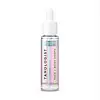What's inside
What's inside
 Key Ingredients
Key Ingredients

 Benefits
Benefits

 Concerns
Concerns

 Ingredients Side-by-side
Ingredients Side-by-side

Water
Skin ConditioningDihydroxyacetone
Skin ConditioningAlcohol Denat.
AntimicrobialGlycerin
HumectantXanthan Gum
EmulsifyingHydrolyzed Soybean Fiber
Skin ProtectingCommiphora Mukul Resin Extract
Skin ConditioningColeus Forskohlii Root Extract
EmollientTocopheryl Acetate
AntioxidantAscorbic Acid
AntioxidantErythrulose
TanningPanthenol
Skin ConditioningAloe Barbadensis Extract
Skin ConditioningCalendula Officinalis Flower Oil
MaskingCitrus Paradisi Fruit Extract
Skin ConditioningJuniperus Communis Fruit Oil
MaskingLycium Barbarum Fruit Extract
AstringentPunica Granatum Extract
AstringentPolysorbate 80
EmulsifyingDipropylene Glycol
HumectantTriethylene Glycol
MaskingEthylhexylglycerin
Skin ConditioningSodium Metabisulfite
AntioxidantParfum
MaskingHexyl Cinnamal
PerfumingLimonene
PerfumingLinalool
PerfumingGeraniol
PerfumingSodium Hydroxide
BufferingPhenoxyethanol
PreservativeWater, Dihydroxyacetone, Alcohol Denat., Glycerin, Xanthan Gum, Hydrolyzed Soybean Fiber, Commiphora Mukul Resin Extract, Coleus Forskohlii Root Extract, Tocopheryl Acetate, Ascorbic Acid, Erythrulose, Panthenol, Aloe Barbadensis Extract, Calendula Officinalis Flower Oil, Citrus Paradisi Fruit Extract, Juniperus Communis Fruit Oil, Lycium Barbarum Fruit Extract, Punica Granatum Extract, Polysorbate 80, Dipropylene Glycol, Triethylene Glycol, Ethylhexylglycerin, Sodium Metabisulfite, Parfum, Hexyl Cinnamal, Limonene, Linalool, Geraniol, Sodium Hydroxide, Phenoxyethanol
Olea Europaea Fruit Oil
MaskingBis-Diglyceryl Polyacyladipate-2
EmollientCaprylic/Capric Triglyceride
MaskingCocos Nucifera Oil
MaskingEuphorbia Cerifera Cera
AstringentHelianthus Annuus Seed Wax
Skin ConditioningPolyglyceryl-2 Triisostearate
EmulsifyingHydrogenated Castor Oil Dimer Dilinoleate
Skin ConditioningMango Butter Dimer Dilinoleyl Esters/Dimer Dilinoleate Copolymer
EmollientButyrospermum Parkii Butter
Skin ConditioningPersea Gratissima Oil
Skin ConditioningPhytosteryl/Isostearyl/Cetyl/Stearyl/Behenyl Dimer Dilinoleate
Skin ConditioningSilica
AbrasiveParfum
MaskingCera Microcristallina
Emulsion StabilisingHydrogenated Rapeseed Oil
EmollientCaprylyl Glycol
EmollientSorbitan Isostearate
EmulsifyingTheobroma Cacao Seed Butter
EmollientTocopheryl Acetate
AntioxidantRebaudioside A
Skin ConditioningPentaerythrityl Tetra-Di-T-Butyl Hydroxyhydrocinnamate
AntioxidantRicinus Communis Seed Oil
MaskingBenzyl Alcohol
PerfumingBenzyl Benzoate
AntimicrobialLimonene
PerfumingLinalool
PerfumingCitrus Aurantium Peel Oil
Geranyl Acetate
PerfumingCitrus Limon Peel Oil
MaskingGeraniol
PerfumingCitronellol
PerfumingCitral
PerfumingTocopherol
AntioxidantTriethoxycaprylylsilane
Titanium Dioxide
Cosmetic ColorantCI 77891
Cosmetic ColorantCI 15850
Cosmetic ColorantOlea Europaea Fruit Oil, Bis-Diglyceryl Polyacyladipate-2, Caprylic/Capric Triglyceride, Cocos Nucifera Oil, Euphorbia Cerifera Cera, Helianthus Annuus Seed Wax, Polyglyceryl-2 Triisostearate, Hydrogenated Castor Oil Dimer Dilinoleate, Mango Butter Dimer Dilinoleyl Esters/Dimer Dilinoleate Copolymer, Butyrospermum Parkii Butter, Persea Gratissima Oil, Phytosteryl/Isostearyl/Cetyl/Stearyl/Behenyl Dimer Dilinoleate, Silica, Parfum, Cera Microcristallina, Hydrogenated Rapeseed Oil, Caprylyl Glycol, Sorbitan Isostearate, Theobroma Cacao Seed Butter, Tocopheryl Acetate, Rebaudioside A, Pentaerythrityl Tetra-Di-T-Butyl Hydroxyhydrocinnamate, Ricinus Communis Seed Oil, Benzyl Alcohol, Benzyl Benzoate, Limonene, Linalool, Citrus Aurantium Peel Oil, Geranyl Acetate, Citrus Limon Peel Oil, Geraniol, Citronellol, Citral, Tocopherol, Triethoxycaprylylsilane, Titanium Dioxide, CI 77891, CI 15850
 Reviews
Reviews

Ingredients Explained
These ingredients are found in both products.
Ingredients higher up in an ingredient list are typically present in a larger amount.
Geraniol is used to add fragrance/parfum to a product. It is the main component of citronellol. It is a monoterpenoid and an alcohol.
Monoterpenes are naturally found in many parts of different plants.
Geraniol can be found in many essential oils including Rose Oil and Citronella Oil. The scent of Geraniol is often described as "rose-like". Many foods also contain Geraniol for fruit flavoring.
Geraniol can irritate the skin when exposed to air. However, irritation depends on the ability of geraniol to penetrate into the skin. In general, geraniol is not able to penetrate skin easily.
Geraniol is colorless and has low water-solubility. However, it is soluble in common organic solvents.
Like citronellol, it is a natural insect repellent.
2,6-Octadien-1-ol, 3,7-dimethyl-, (2E)-
Learn more about GeraniolLimonene is a fragrance that adds scent and taste to a formulation.
It's found in the peel oil of citrus fruits and other plants such as lavender and eucalyptus. The scent of limonene is generally described as "sweet citrus".
Limonene acts as an antioxidant, meaning it helps neutralize free radicals.
When exposed to air, oxidized limonene may sensitize the skin. Because of this, limonene is often avoided by people with sensitive skin.
The term 'fragrance' is not regulated in many countries. In many cases, it is up to the brand to define this term. For instance, many brands choose to label themselves as "fragrance-free" because they are not using synthetic fragrances. However, their products may still contain ingredients such as essential oils that are considered a fragrance.
Learn more about LimoneneLinalool is a fragrance and helps add scent to products. It's derived from common plants such as cinnamon, mint, citrus, and lavender.
Like Limonene, this ingredient oxidizes when exposed to air. Oxidized linalool can cause allergies and skin sensitivity.
This ingredient has a scent that is floral, spicy tropical, and citrus-like.
Learn more about LinaloolParfum is a catch-all term for an ingredient or more that is used to give a scent to products.
Also called "fragrance", this ingredient can be a blend of hundreds of chemicals or plant oils. This means every product with "fragrance" or "parfum" in the ingredients list is a different mixture.
For instance, Habanolide is a proprietary trade name for a specific aroma chemical. When used as a fragrance ingredient in cosmetics, most aroma chemicals fall under the broad labeling category of “FRAGRANCE” or “PARFUM” according to EU and US regulations.
The term 'parfum' or 'fragrance' is not regulated in many countries. In many cases, it is up to the brand to define this term.
For instance, many brands choose to label themselves as "fragrance-free" because they are not using synthetic fragrances. However, their products may still contain ingredients such as essential oils that are considered a fragrance by INCI standards.
One example is Calendula flower extract. Calendula is an essential oil that still imparts a scent or 'fragrance'.
Depending on the blend, the ingredients in the mixture can cause allergies and sensitivities on the skin. Some ingredients that are known EU allergens include linalool and citronellol.
Parfum can also be used to mask or cover an unpleasant scent.
The bottom line is: not all fragrances/parfum/ingredients are created equally. If you are worried about fragrances, we recommend taking a closer look at an ingredient. And of course, we always recommend speaking with a professional.
Learn more about ParfumTocopheryl Acetate is AKA Vitamin E. It is an antioxidant and protects your skin from free radicals. Free radicals damage the skin by breaking down collagen.
One study found using Tocopheryl Acetate with Vitamin C decreased the number of sunburned cells.
Tocopheryl Acetate is commonly found in both skincare and dietary supplements.
Learn more about Tocopheryl Acetate